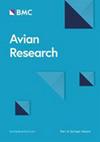Regional differences in wintering habitat selection strategies of Siberian Crane (Leucogeranus leucogeranus) and ecological network construction of key wintering areas
IF 1.7
2区 生物学
Q1 ORNITHOLOGY
引用次数: 0
Abstract
Poyang Lake (PYL) and the Yellow River Delta (YRD) are two critical wintering areas for the Siberian Crane (Leucogeranus leucogeranus) along the East Asian–Australasian Flyway in China. Based on nearly two decades of remote sensing and environmental data, this study used the MaxEnt model to assess wintering habitat suitability in Poyang Lake (PYL) and the Yellow River Delta (YRD). Landscape pattern and ecological network (EN) analyses were integrated to examine habitat changes and their impact on Siberian Crane distribution. In PYL, land use/land cover (LULC) change was driven primarily by water level fluctuations, leading to transitions among natural habitat types. In contrast, LULC change in YRD was dominated by anthropogenic activities, with widespread conversion of natural habitats into artificial habitats. In both regions, Siberian Cranes favored wetlands that are food-rich, flat, and minimally disturbed. In PYL, ecological sources were mainly found in sub-lakes of nature reserves and nearby moist areas, averaging 87.42 km2. In the YRD, sources were distributed across tidal flats, paddy land, and grasslands, with a larger mean area of 198.37 km2. Mann–Kendall tests showed significant trends in PYL, including increased patch density and decreased EN cumulative resilience. The maximum habitat suitability in the YRD significantly declined. Comparative analysis revealed that PYL had significantly higher habitat suitability and EN cumulative resilience, whereas the YRD had larger but more fragmented habitats. By introducing key stepping-stone nodes to optimize the ENs, the connectivity and resilience of PYL's EN were notably enhanced. Although improvements in the YRD were less marked, the optimization scheme still improved the security of the crane migration network. Based on the findings, it is recommended to implement refined water level management in PYL to maintain the stability of sub-lakes and adjacent wetlands, and to strengthen the protection of natural wetlands in the YRD by limiting the expansion of artificial land use, in order to mitigate habitat fragmentation.

西伯利亚鹤越冬生境选择策略的区域差异及重点越冬区生态网络建设
鄱阳湖(PYL)和黄河三角洲(YRD)是中国东亚-澳大拉西亚飞行路线上西伯利亚鹤(Leucogeranus Leucogeranus)的两个重要越冬区。基于近20年的遥感和环境数据,利用MaxEnt模型对鄱阳湖和黄河三角洲地区的越冬生境适宜性进行了评价。采用景观格局分析和生态网络分析相结合的方法,探讨了生境变化及其对西伯利亚鹤分布的影响。在PYL,土地利用/土地覆盖(LULC)变化主要受水位波动驱动,导致自然栖息地类型的转换。与此相反,长三角地区的土地利用碳储量变化主要受人为活动的影响,自然生境向人工生境的转变较为普遍。在这两个地区,西伯利亚鹤都喜欢食物丰富、平坦、受干扰最小的湿地。生态源主要分布在自然保护区的分湖和附近湿润区,平均为87.42 km2。在长三角地区,源区主要分布在滩地、水田和草地上,平均面积198.37 km2。Mann-Kendall试验显示PYL有明显的趋势,包括斑块密度增加和EN累积恢复力下降。长三角地区的最大生境适宜性显著下降。对比分析表明,PYL的生境适宜性和EN累积恢复力显著高于YRD,而YRD的生境更大但更破碎化。通过引入关键节点对网络进行优化,显著提高了PYL网络的连通性和弹性。虽然优化方案对长三角的改善不明显,但仍提高了起重机迁移网络的安全性。在此基础上,建议在长江三角洲实施精细化水位管理,以保持子湖和邻近湿地的稳定,并通过限制人工土地利用的扩大,加强对长江三角洲天然湿地的保护,以减轻生境破碎化。
本文章由计算机程序翻译,如有差异,请以英文原文为准。
求助全文
约1分钟内获得全文
求助全文
来源期刊

Avian Research
ORNITHOLOGY-
CiteScore
2.90
自引率
16.70%
发文量
456
审稿时长
46 days
期刊介绍:
Avian Research is an open access, peer-reviewed journal publishing high quality research and review articles on all aspects of ornithology from all over the world. It aims to report the latest and most significant progress in ornithology and to encourage exchange of ideas among international ornithologists. As an open access journal, Avian Research provides a unique opportunity to publish high quality contents that will be internationally accessible to any reader at no cost.
 求助内容:
求助内容: 应助结果提醒方式:
应助结果提醒方式:


